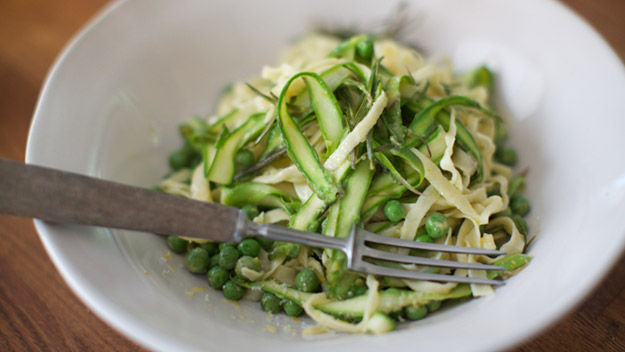Serves 2-3
INGREDIENTS
For the pasta
200g Tipo ‘00’ pasta flour
2 large eggs, preferably free-range or organic
Pinch of salt
Fine polenta or semolina
*(Alternatively use 300g dried linguine or tagliatelle)
For the sauce
30g butter
1 sprig rosemary, picked
8-10 spears asparagus
2 large handfuls green peas
Zest and juice of 1 lemon
Extra virgin olive oil
Fresh parmesan, to serve
Method
Making your pasta
Place the flour on a board or in a bowl and make a well in the centre. Crack the eggs in the well, add a pinch of salt then with a fork, mix the egg into the flour as much as possible so it’s not sticky. Don’t worry if there are lumps in the dough. Keep mixing and when crumbs form put it on a floured surface and knead together. Once it is all combined, knead the dough until you have a silky smooth elastic dough. You are aiming to achieve a playdough-like texture. If your dough is crumbly (too dry) add a teaspoon of olive oil. If the dough is sticks to your hands (too wet) add a little extra flour. Cover with cling film and rest for 30 minutes.
Take tennis ball-sized amounts of the dough squash it flat with your fingers (remember to keep the rest of your dough covered with the cling film so it doesn’t go dry and crusty). Place on a floured work surface and using a rolling pin roll into a rough square sheet of pasta which is about 2 playing cards thick. Sprinkle some flour over both sides of the pasta sheet and fold it into three. Then using a sharp knife, cut strips 3mm wide and unravel so you have long linguine.
If you are using a pasta roller, take your flattened tennis ball-sized piece of dough and push it through the pasta roller on the widest setting. Fold into thirds, then repeat 3 times. Once you have a rough square shape, start working it through the machine, taking it down one setting at a time, until the thinnest setting. If your pasta is too sticky, it won’t go through smoothly, so add a little flour to each side before you put it through the roller. Then roll it through the setting for tagliatelle or thin linguine.
Leave the linguine on trays with a dusting of fine polenta or semolina to stop it sticking, or you can hang them individually on clean coat hangers. Repeat the process until you have used all the remaining dough. Get a large pan of salted water on a high heat to boil.
Making the sauce
This part is super quick so we would advise getting all your ingredients ready before you cook your pasta. Chop the ends off your asparagus and discard, then chop the heads off (but don’t throw these away). Using a speed peeler (see below on how to use and where to buy), finely peel the asparagus stalks into thin strips.
Melt the butter in a medium-sized frying pan, and when it starts to bubble like champagne add the picked rosemary, cooking until lovely and crispy. Then add your asparagus strips and heads to the pan along with the fresh peas and lemon zest , stirring together. Season to taste with salt and pepper.
Add the linguini to the boiling water and cook until al dente – fresh pasta will take under 2 minutes to cook.
Once the pasta is cooked using tongs add the pasta to the saucepan and mix together. Serve in a bowl with a squeeze of lemon.


